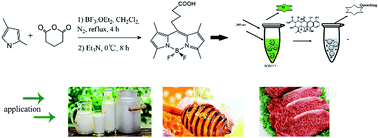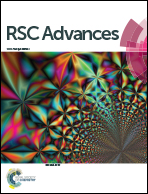First report on a BODIPY-based fluorescent probe for sensitive detection of oxytetracycline: application for the rapid determination of oxytetracycline in milk, honey and pork
Abstract
A new BODIPY-based fluorescent probe (S) for oxytetracycline bearing hydrophilic carboxyl has been designed and synthesized. Fluorescence is quenched by oxytetracycline (OTC), and the effect was used to develop a method for the determination of OTC. This is the first report on the determination of OTC by a BODIPY-based “turn-off” fluorescence probe, which provides a sensitive and selective method for OTC detection. S exhibited higher properties, such as acting as a “naked eye” probe, stronger anti-jamming capability, outstanding thermal stability, good stability to pH, fast-response characteristics, and better live-cells imaging with low cytotoxicity when compared with other probes. Moreover, this is the first time that one chemosensor could be successfully applied to OTC imaging in zebrafish, which demonstrated its excellent organism permeability. Furthermore, the feasibility of the developed assays in milk, honey, and pork samples was verified through recovery experiments using spiked samples. Under the optimum conditions, good linearity was obtained in the range of 0–42 µM and the recoveries ranged from 101.3% to 104.8%, 101.9% to 107.9%, and 98.3% to 109.5% for milk, honey, and pork, respectively, with relative standard deviations less than 1.74%.


 Please wait while we load your content...
Please wait while we load your content...